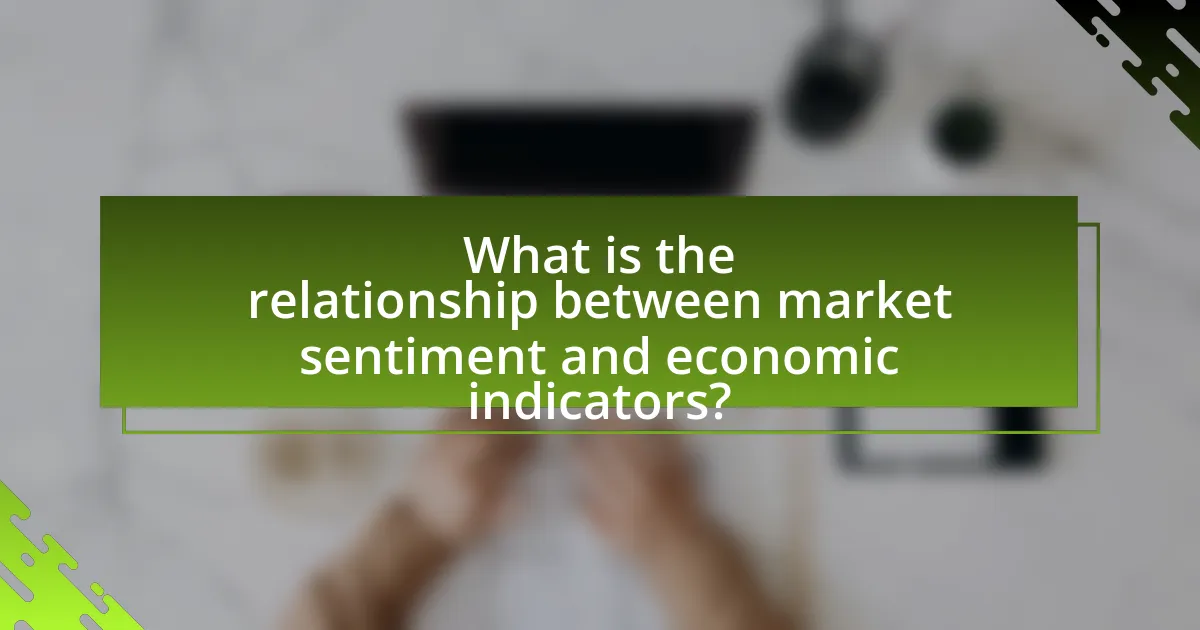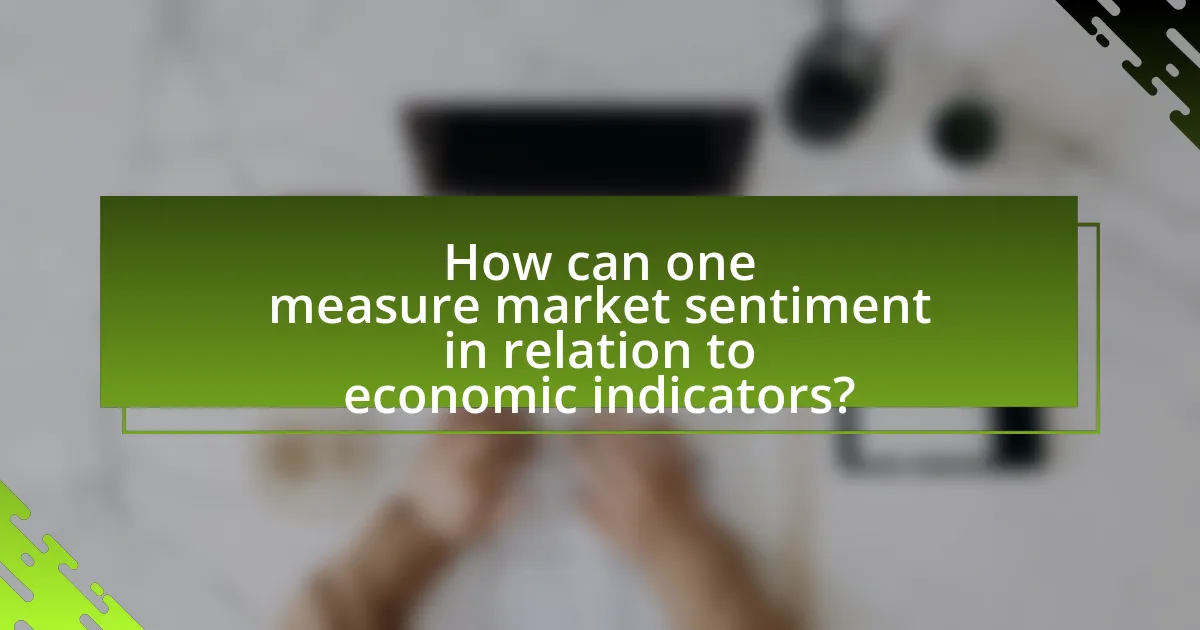The article explores the intricate relationship between market sentiment and economic indicators, highlighting how investor perceptions of economic conditions can significantly influence market behavior. It examines the feedback loop between sentiment and indicators, detailing how positive economic data typically fosters bullish sentiment, while negative indicators can lead to bearish market conditions. Key economic indicators such as GDP, unemployment rates, and consumer confidence are identified as critical factors shaping market sentiment. Additionally, the article discusses the impact of news events, social media, and technological tools on sentiment analysis, providing insights into how investors can leverage this relationship for informed decision-making.

What is the relationship between market sentiment and economic indicators?
Market sentiment and economic indicators are closely interconnected, as market sentiment often reflects investors’ perceptions of economic conditions. Positive economic indicators, such as rising GDP or low unemployment rates, typically lead to bullish market sentiment, driving stock prices higher. Conversely, negative indicators, like high inflation or declining consumer confidence, can result in bearish sentiment, causing market downturns. Historical data supports this relationship; for instance, during the 2008 financial crisis, plummeting economic indicators correlated with a significant drop in market sentiment, leading to a prolonged bear market. Thus, market sentiment serves as a barometer for economic health, influenced directly by the prevailing economic indicators.
How do market sentiment and economic indicators interact?
Market sentiment and economic indicators interact through a feedback loop where sentiment influences market behavior and economic indicators reflect underlying economic conditions. Positive market sentiment can lead to increased investment and spending, which may improve economic indicators such as GDP growth and employment rates. Conversely, negative sentiment can result in reduced consumer confidence and spending, negatively impacting economic indicators. For example, during the COVID-19 pandemic, initial negative sentiment led to a sharp decline in stock markets, which was reflected in economic indicators like unemployment rates and consumer spending. This interaction highlights how perceptions and actual economic data can shape each other, influencing overall market dynamics.
What are the key economic indicators that influence market sentiment?
Key economic indicators that influence market sentiment include Gross Domestic Product (GDP), unemployment rates, inflation rates, consumer confidence indices, and interest rates. GDP reflects the overall economic health, with higher growth often leading to positive market sentiment. Unemployment rates indicate labor market strength; lower rates typically boost investor confidence. Inflation rates affect purchasing power and cost of living, influencing consumer behavior and market outlook. Consumer confidence indices measure optimism about the economy, directly impacting spending and investment decisions. Interest rates, set by central banks, influence borrowing costs and investment, with lower rates generally fostering a more favorable market sentiment.
How does market sentiment reflect changes in economic indicators?
Market sentiment reflects changes in economic indicators through investor perceptions and reactions to data releases. When economic indicators, such as GDP growth, unemployment rates, or inflation figures, show positive trends, market sentiment typically becomes optimistic, leading to increased buying activity in financial markets. Conversely, negative economic indicators can trigger pessimism, resulting in selling pressure. For example, a report indicating a rise in unemployment may lead to a decline in stock prices as investors anticipate reduced consumer spending. Historical data supports this relationship; during the 2008 financial crisis, negative economic indicators significantly impacted market sentiment, causing sharp declines in stock indices.
Why is understanding this relationship important for investors?
Understanding the relationship between market sentiment and economic indicators is crucial for investors because it enables them to make informed decisions based on the psychological and economic landscape. Investors who grasp this relationship can anticipate market movements, as positive sentiment often correlates with rising economic indicators, such as GDP growth or low unemployment rates, while negative sentiment may signal economic downturns. For instance, a study by the National Bureau of Economic Research found that investor sentiment can predict stock market returns, highlighting the importance of sentiment analysis in investment strategies.
What insights can investors gain from analyzing market sentiment?
Investors can gain insights into potential market trends and price movements by analyzing market sentiment. Market sentiment reflects the overall attitude of investors toward a particular security or financial market, often indicating whether they are feeling optimistic or pessimistic. For instance, a study by Baker and Wurgler (2006) found that investor sentiment significantly affects stock prices, with high sentiment correlating with increased stock valuations. Additionally, sentiment analysis can help investors identify overbought or oversold conditions, enabling them to make more informed trading decisions. By understanding sentiment indicators, such as consumer confidence indices or social media trends, investors can better anticipate market shifts and adjust their strategies accordingly.
How can economic indicators guide investment decisions based on market sentiment?
Economic indicators can guide investment decisions based on market sentiment by providing quantitative data that reflects the overall economic health and investor confidence. For instance, indicators such as GDP growth rates, unemployment figures, and consumer confidence indices can signal whether the economy is expanding or contracting. When these indicators show positive trends, market sentiment typically becomes optimistic, leading investors to increase their investments in stocks or other assets. Conversely, negative indicators can lead to pessimism, prompting investors to sell off assets or seek safer investments. Historical data supports this relationship; for example, during the 2008 financial crisis, declining economic indicators correlated with a significant drop in market sentiment, resulting in a sharp decline in stock prices. Thus, by analyzing economic indicators, investors can make informed decisions that align with prevailing market sentiment.

What factors influence market sentiment?
Market sentiment is influenced by various factors, including economic indicators, news events, investor behavior, and market trends. Economic indicators such as GDP growth, unemployment rates, and inflation directly impact investor perceptions and expectations about future market performance. For instance, a rise in unemployment rates may lead to negative sentiment as it suggests economic weakness, while strong GDP growth can boost confidence. Additionally, news events, including geopolitical developments and corporate earnings reports, can rapidly shift sentiment by altering perceptions of risk and opportunity. Investor behavior, driven by psychological factors like fear and greed, also plays a crucial role; for example, during market downturns, fear can lead to panic selling, further depressing sentiment. Lastly, prevailing market trends, whether bullish or bearish, can create a feedback loop that reinforces sentiment, as rising prices may attract more buyers, while falling prices can lead to increased selling pressure.
How do news events impact market sentiment?
News events significantly impact market sentiment by influencing investor perceptions and behaviors. For instance, positive news such as strong economic data or favorable corporate earnings can lead to increased investor confidence, resulting in rising stock prices. Conversely, negative news, such as geopolitical tensions or disappointing economic reports, can create fear and uncertainty, causing market declines. Historical data shows that major events, like the 2008 financial crisis, led to drastic shifts in market sentiment, with the S&P 500 dropping over 50% from its peak. This demonstrates that news events serve as catalysts for market movements, shaping the overall sentiment and direction of financial markets.
What types of news are most influential on market sentiment?
Economic news, corporate earnings reports, geopolitical events, and central bank announcements are the types of news most influential on market sentiment. Economic news, such as employment data and GDP growth rates, directly impacts investor perceptions of economic health. Corporate earnings reports provide insights into company performance, influencing stock prices and investor confidence. Geopolitical events, like conflicts or trade negotiations, can create uncertainty, affecting market stability. Central bank announcements regarding interest rates and monetary policy shape expectations for economic growth and inflation, significantly swaying market sentiment. Historical data shows that significant market movements often correlate with these types of news, underscoring their influence on investor behavior.
How do geopolitical events affect market sentiment?
Geopolitical events significantly influence market sentiment by creating uncertainty and volatility in financial markets. For instance, events such as military conflicts, trade disputes, or political instability can lead to investor anxiety, prompting a sell-off in equities and a flight to safer assets like gold or government bonds. Historical examples include the 2008 financial crisis, where geopolitical tensions contributed to market declines, and the 2020 COVID-19 pandemic, which triggered widespread panic and market drops due to uncertainty about global economic stability. These events often result in shifts in consumer confidence and business investment, further impacting market dynamics.
What role do social media and technology play in shaping market sentiment?
Social media and technology significantly influence market sentiment by facilitating rapid information dissemination and enabling real-time engagement among investors. Platforms like Twitter and Reddit allow users to share opinions and news, which can lead to swift shifts in market perceptions. For instance, the GameStop stock surge in early 2021 was largely driven by discussions on Reddit, illustrating how collective sentiment can impact stock prices dramatically. Additionally, algorithms used by trading platforms analyze social media trends to inform trading strategies, further intertwining technology with market sentiment dynamics.
How does social media sentiment analysis contribute to understanding market trends?
Social media sentiment analysis significantly contributes to understanding market trends by providing real-time insights into consumer opinions and emotions regarding products, brands, and economic conditions. This analysis leverages large volumes of user-generated content to gauge public sentiment, which can serve as an early indicator of market movements. For instance, a study by Bollen et al. (2011) demonstrated that Twitter sentiment could predict stock market trends with a correlation coefficient of 0.84, indicating a strong relationship between social media sentiment and market behavior. By analyzing sentiment shifts, businesses and investors can make informed decisions, aligning their strategies with emerging market trends.
What technological tools are available for measuring market sentiment?
Technological tools available for measuring market sentiment include social media analytics platforms, sentiment analysis software, and financial market data services. Social media analytics platforms, such as Brandwatch and Hootsuite, analyze user-generated content to gauge public sentiment about brands or markets. Sentiment analysis software, like Lexalytics and MonkeyLearn, employs natural language processing to interpret emotions in text data from news articles and social media. Financial market data services, such as Bloomberg Terminal and Thomson Reuters Eikon, provide sentiment indicators derived from market data and news sentiment analysis, allowing investors to assess market mood and trends. These tools utilize algorithms and data mining techniques to deliver insights that are crucial for understanding market dynamics.

How can one measure market sentiment in relation to economic indicators?
Market sentiment can be measured in relation to economic indicators through various quantitative and qualitative methods. One effective approach is analyzing investor surveys, such as the American Association of Individual Investors (AAII) sentiment survey, which gauges the mood of individual investors regarding market direction based on economic conditions. Additionally, financial market data, including stock price movements and trading volumes, can reflect sentiment shifts in response to economic reports like GDP growth, unemployment rates, and inflation figures. For instance, a positive GDP report often correlates with rising stock prices, indicating bullish sentiment. Furthermore, sentiment analysis tools that utilize natural language processing can evaluate news articles and social media posts to quantify public sentiment towards economic indicators, providing a comprehensive view of market psychology.
What are the common methods for measuring market sentiment?
Common methods for measuring market sentiment include surveys, social media analysis, and market indicators. Surveys, such as the Consumer Confidence Index, gauge public sentiment by asking individuals about their economic outlook. Social media analysis utilizes natural language processing to assess sentiment from platforms like Twitter and Facebook, providing real-time insights into public opinion. Market indicators, such as the Volatility Index (VIX), reflect investor sentiment based on market movements and trading behavior. These methods collectively offer a comprehensive view of market sentiment, supported by empirical data from various financial studies and reports.
How do surveys and polls contribute to sentiment analysis?
Surveys and polls contribute to sentiment analysis by providing quantitative data on public opinions and feelings regarding specific topics or events. This data is collected through structured questions that gauge respondents’ attitudes, allowing analysts to quantify sentiment trends over time. For instance, the University of Michigan’s Consumer Sentiment Index uses survey data to track consumer confidence, which correlates with economic performance indicators. By analyzing the responses, researchers can identify shifts in sentiment that may predict market movements or economic changes, thus reinforcing the connection between public sentiment and economic indicators.
What role do sentiment indices play in economic analysis?
Sentiment indices serve as crucial indicators in economic analysis by reflecting the collective mood and expectations of consumers and investors. These indices, such as the Consumer Confidence Index and the Purchasing Managers’ Index, provide insights into future economic activity, as they often correlate with spending and investment behaviors. For instance, a high consumer confidence level typically signals increased consumer spending, which drives economic growth. Empirical studies have shown that sentiment indices can predict stock market trends and economic cycles, reinforcing their importance in economic forecasting and decision-making.
How can economic indicators be used to predict market sentiment trends?
Economic indicators can predict market sentiment trends by providing quantitative data that reflects the overall health of the economy, influencing investor perceptions and behaviors. For instance, indicators such as GDP growth rates, unemployment rates, and consumer confidence indices serve as benchmarks for economic performance. When GDP growth is strong, it typically correlates with positive market sentiment, as investors anticipate higher corporate earnings. Conversely, rising unemployment rates often lead to negative sentiment, as they signal economic distress. Historical data supports this relationship; for example, during the 2008 financial crisis, a significant drop in consumer confidence preceded a sharp decline in stock market performance, illustrating how economic indicators can forecast shifts in market sentiment.
What historical patterns exist between economic indicators and market sentiment?
Historical patterns indicate a strong correlation between economic indicators and market sentiment, where positive economic data often leads to increased investor confidence and bullish market behavior. For instance, during periods of rising GDP growth, such as in the post-2008 recovery, market sentiment improved significantly, reflected in stock market rallies. Conversely, negative indicators like high unemployment rates or declining consumer confidence typically result in bearish sentiment, as seen during the 2008 financial crisis when the S&P 500 dropped significantly in response to deteriorating economic conditions. These patterns demonstrate that economic indicators serve as critical signals influencing market sentiment, shaping investor expectations and behaviors.
How can predictive analytics enhance understanding of market sentiment?
Predictive analytics enhances understanding of market sentiment by analyzing historical data and identifying patterns that indicate future market behavior. By utilizing algorithms and statistical models, predictive analytics can forecast shifts in consumer sentiment based on various economic indicators, such as employment rates, inflation, and consumer spending. For instance, a study by the National Bureau of Economic Research found that predictive models incorporating sentiment analysis can improve the accuracy of economic forecasts by up to 20%. This demonstrates that predictive analytics not only provides insights into current market sentiment but also anticipates future trends, allowing businesses and investors to make informed decisions.
What practical strategies can investors use to leverage market sentiment and economic indicators?
Investors can leverage market sentiment and economic indicators by employing strategies such as sentiment analysis, trend following, and economic data monitoring. Sentiment analysis involves assessing public opinion through social media, news articles, and market reports to gauge investor mood, which can influence stock prices. For instance, a surge in positive sentiment often correlates with rising stock prices, as seen during bullish market phases.
Trend following allows investors to capitalize on prevailing market movements by identifying and riding trends indicated by price charts and momentum indicators. Historical data shows that following established trends can yield higher returns, particularly in volatile markets.
Monitoring economic indicators, such as GDP growth rates, unemployment figures, and consumer confidence indices, provides insights into the overall economic health, enabling investors to make informed decisions. For example, a rising GDP often signals a robust economy, prompting investors to increase their equity exposure. By combining these strategies, investors can effectively navigate market fluctuations and enhance their investment outcomes.
How can investors develop a sentiment-based investment strategy?
Investors can develop a sentiment-based investment strategy by analyzing market sentiment indicators, such as social media trends, news sentiment, and investor surveys. These indicators provide insights into the collective mood of the market, which can influence asset prices. For instance, a study by Baker and Wurgler (2006) found that investor sentiment significantly affects stock returns, particularly for smaller firms and growth stocks. By integrating sentiment analysis tools and techniques, such as natural language processing to gauge public sentiment from news articles and social media, investors can make informed decisions that align with prevailing market emotions. This approach allows investors to capitalize on market inefficiencies driven by sentiment fluctuations.
What are the best practices for integrating economic indicators into market sentiment analysis?
The best practices for integrating economic indicators into market sentiment analysis include selecting relevant indicators, ensuring timely data collection, and employing statistical methods for correlation analysis. Relevant indicators such as GDP growth rates, unemployment rates, and inflation figures provide a foundation for understanding economic conditions that influence market sentiment. Timely data collection is crucial, as market sentiment can shift rapidly in response to new economic information; for instance, the release of employment data can significantly impact investor confidence. Statistical methods, such as regression analysis, can quantify the relationship between economic indicators and market sentiment, allowing analysts to identify trends and make informed predictions. These practices enhance the accuracy and reliability of sentiment analysis, ultimately leading to better investment decisions.



